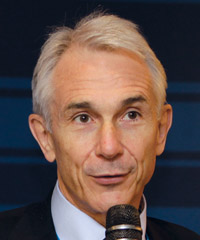News Backgrounder
Industry in upward profit cycle says IATA
Politics and fuel, the usual suspects when there is a sudden shift in the bottom line of the global airline industry, have resulted in a US$1 billion profit downgrade, to US$18.7 billion, for the coming year, said the International Air Transport Association (IATA), but its not all bad news.
April 1st 2014
The world’s airlines remain on track to report a profit this year, but there are number of risks threatening the industry’s ability to make money in the months ahead. Read More »
The good news said IATA director general and CEO, Tony Tyler, in March, is that airlines are expect to report a global profit of $18.7 billion this year, marginally down from the $19.7 billion forecast last December, with Asia-Pacific airlines to realize a profit of $3.7 billion in 2014.
 |
| Tony Tyler, director general and CEO, International Air Transport Association: “We are seeing a cyclical uplift in demand” |
The bad news is that it is not good enough, IATA said. For an industry that generates $745 billion in revenues, this profit level represents an average net margin of 2.5%,” said Tyler. “Put another way, the average fare is about $200 (including ancillaries) and airlines will make about $5.65 for every departing passenger. So, running an airline remains a very tough business. It is closely tied to the economic cycle and vulnerable to many risks.”
Among those risks, the IATA boss said, is political instability in the Ukraine that is pushing up oil prices. This was the main negative driver of the downward revision of profits. “I have also spoken about the negative impact on traffic of growth led by markets. Many countries—including Turkey, India, Indonesia and South Africa—have tightened monetary policy in order to protect exchange rates—slowing economic growth. And we see this trend continuing,” he said.
The upside of the revised forecast, Tyler explained, was that the numbers in an industry forecast can give a false impression. “Firstly, while this is a $1 billion downgrade, it comes on revenues of some $745 billion. On such a large revenue base, a $1 billion shift is equal to less than a seventh of one percent,” he said.
“So, rather than being a substantial downgrade, it is probably better characterized as a tweak and the overall forecast is still very aligned to our December thinking. Basically, the fuel bill will be about $3 billion higher than we expected in December. And this will be partially offset by an increase in revenues of $2 billion, primarily due to stronger cargo markets.
“Secondly, even though this is a forecast downgrade, the overall story for the industry is positive. In 2012 airlines made $6.1 billion. Last year ended with a $12.9 billion profit. And this year will continue that improving trend. Third, in absolute terms, an overall profit of $18.7 billion is a significant amount of money—even for a tech company or social media start-up. And considering that, on balance, the industry has endured more annual losses than annual profits since 2000, staying in the black is in itself an achievement that reflects the major restructuring that has taken place.”
Cargo remains a concern, but there are signs the sector is improving. “The cargo side of the business is difficult, but doing better than we expected a few months ago. Since 2010, revenues have hovered around the $60 billion level while volumes sat at the 50 million tonne mark. There are pressures from ‘on shoring’ of supply chains and protectionist measures that are slowing the growth in world trade and holding back the cargo side of the business,” Tyler said.
“Nonetheless, we are seeing a cyclical upswing in demand. As a result of this, we increased our revenue outlook to $63 billion. That is $2 billion better than 2013 and $3 billion better than we forecast in December.”
The best performing region in terms of income is expected to be North America, where airlines are forecast to post combined profits of $8.6 billion.
Projected Asia-Pacific profits of $3.7 billion are better than the global average, but still lean in business terms. IATA said the position of airlines in the region has been helped by the slightly better outlook for cargo markets.
“Airlines in the Asia-Pacific have the largest share of the international air cargo market,” said Tyler. “However, the turmoil in foreign exchange markets earlier this year adversely affected growth prospects for large economies in the region like India and Indonesia. Even China has slowed, albeit to a much lesser extent. The resulting adverse impact on passenger revenues more than offsets the improvement in cargo. Our forecast for the profits of airlines in this region in 2014 is $400 million less than the previous projection,” Tyler said.
“Fuel costs, currently accounting for some 30% of costs, continue to be the major driver of the industry forecasts. IATA said recent political tensions have sparked an upward trend with oil prices expected to average $108/barrel (Brent), $3.50 higher than the previous forecast. Jet fuel prices are expected to be higher at $124.6 per barrel, which is a $1.7 per barrel increase from previously forecast (and unchanged from 2013). Overall, fuel costs are expected to rise by some $3 billion to $213 billion compared to the December forecast.”